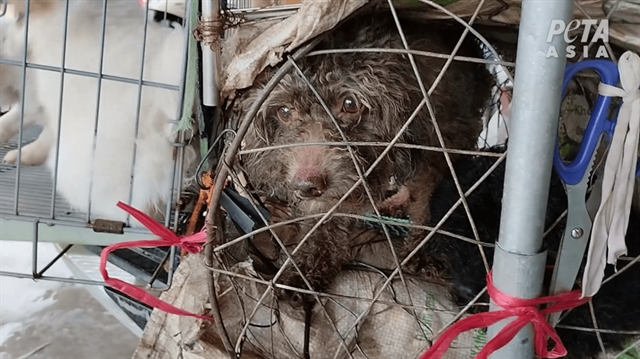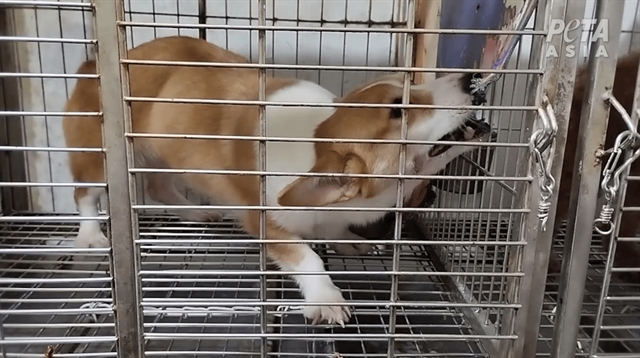 Society
Society

The latest investigation of the People for the Ethical Treatment of Animals (PETA) revealed the distressing situations that dogs are kept in at breeding facilities in Việt Nam, many of which distribute dogs for major and “reputable” stores.
In an exclusive Zoom interview with Việt Nam News reporter Vân Nguyễn, PETA Asia’s spokesperson Bùi Thu Hà talks about their investigations and how the public and authorities can act to prevent animals' suffering in these breeding facilities.
Could you please tell us about the investigation, what have you found and what is the most concerning finding?
Our investigation showed that in these dog breeding facilities, dogs lived in poor conditions. They were cramped in dirty and rusty cages with urine and faeces found on the floor. The dogs there did not have access to proper hygiene and their fur was often matted or tangled, while long-haired dogs had their fur matted together.
The dogs' nails were also too long and some had fungal infections. PETA also observed that the dogs had limited contact with humans and were not adequately fed or exposed to sunlight, leading to calcium deficiencies and lung diseases.
Some breeders even admitted that they had cut off puppies' tails because they sell better that way.
PETA showed the video to two veterinarians and they concluded that the dogs at these facilities experience unacceptable suffering and pain and inhumane treatment.
The biggest concern is probably that many dogs are constantly trembling and unable to stand firmly due to calcium deficiency when pregnant or giving birth.
Having too many puppies leads to malnutrition, calcium deficiency, and constantly trembling and unstable conditions. Some dogs have to eat and sleep while standing or lying directly on their own faeces or urine.
When workers or breeders approach, the dogs became scared and fearful, and stiffened up as they were psychologically stressed.
One breeder has admitted that their daughter broke a dog's leg and regularly beats the dogs. These are all concerning issues.

|
| A dog is suffering in a small cage. |
Which types of facilities did PETA select to investigate? How many dogs are estimated to be kept in them in total?
In Việt Nam, PETA visited 20 different facilities nationwide that breed and distribute dogs for sale throughout the country. For the safety of the investigators, PETA did not disclose the specific locations of these facilities. We chose facilities that distribute dogs to stores or large, reputable breeding facilities in Việt Nam.
The number ranges from ten to dozens of dogs depending on the size of each farm.
Are the horrible conditions found in all facilities investigated? And about inbreeding, does it happen here in Việt Nam’s facilities?
These conditions are found on all of these farms, and they happen not just in Việt Nam, but all over the world.
The practice of inbreeding dogs and forcing them to live in such terrible conditions is widespread in many countries.
With regard to inbreeding, PETA has investigated this and found that it is a common practice on many farms today. Breeders do not prioritise the health of the animals, but focus on breeding as many dogs as possible to make a profit. This is a very concerning issue.
How did PETA initiate this investigation?
We noticed that many dog owners are not aware of what happens behind the pet stores or breeding facilities that they buy from.
They simply want to own a dog and unwittingly enrich these facilities that mistreat animals.
From this, PETA wants to show the importance of adopting animals from shelters and rescue centres rather than buying from these types of facilities.
Does a breeding facility that ensures animal welfare exist? If so what should it look like?
Right now, I cannot set an ideal standard for what a breeding facility should be like. While most facilities can provide good conditions for animals, they cannot guarantee their quality of life during breeding.
For example, when breeding many dogs, they are often kept in small cages or rooms, which hinders their physical and mental needs. They cannot engage in activities, such as running and socialising with other animals or enjoying the sun. These are things that most breeding facilities cannot provide, and having too many dogs can lead to overload. The number of animals and dogs that are not adopted is often abandoned or thrown away, leading to further suffering for the animals.
Rather than creating new animals, we should adopt animals that are already in need of a home. Rescue centres are better than creating more new animals and causing more suffering for animals that are neglected or not cared for.
Adopting animals from rescue centers is encouraged by PETA, and currently, an estimated 25 per cent of animals in shelters are purebred. If you like purebred dogs or cats, you can still find them in rescue centres instead of buying them from breeding facilities.

|
| A dog bites broken cage. Photos courtesy of PETA Asia |
What are PETA's next steps following the investigation?
Our next step is to file a complaint with the Ministry of Agriculture and Rural Development. We see that there are possible violations of the Law on Veterinary Medicine (2015) and the Law on Animal Husbandry (2018).
PETA also wants to urge the ministry to investigate these breeding facilities and encourage people not to buy animals from pet stores or breeding facilities, but instead to adopt them from rescue centres and neuter their own pets to prevent animal overpopulation.
Under the law, adequate food and water along with necessary veterinary care must be provided for animals. In addition, unnecessary pain and suffering to the animals must be avoided during the process of raising or slaughtering them.
Dogs having broken legs, being beaten, and malnourished, psychological stress, fear, and anxiety during breeding and slaughter are violations of animal welfare laws.
Based on the assessment of PETA, do these incidents occur in other animals?
These violations are not limited to breeding facilities for dogs and cats, but also occur in other animal farming operations. Our investigations show that these incidents happen in most dog and cat breeding facilities in Việt Nam, as well as in many countries around the world, such as South Korea, Japan, and the United States.
We have also conducted investigations of many facilities worldwide and found that this is a common issue. Most of the dogs and cats in these breeding facilities are not receiving the necessary veterinary care and are not having their basic needs met, which is a widespread problem in animal farming operations.
The demand for specific breeds of dogs and cats has increased in Việt Nam in recent years. What are the implications of this trend?
Many people who love dogs and cats may only see the cute and adorable side of these animals and may not be aware of the suffering and hardships that these animals may experience in breeding facilities.
This can lead to a continued cycle of animal suffering, where dogs and cats are forced to continuously breed and undergo repeated pregnancies, leading to exhaustion and other health problems.
It is important for people who love animals to be aware of the conditions that these animals are bred and raised. They can do this by adopting animals from shelters and rescue centres.
The public plays a significant role in limiting this trend by adopting animals instead of buying them. — VNS